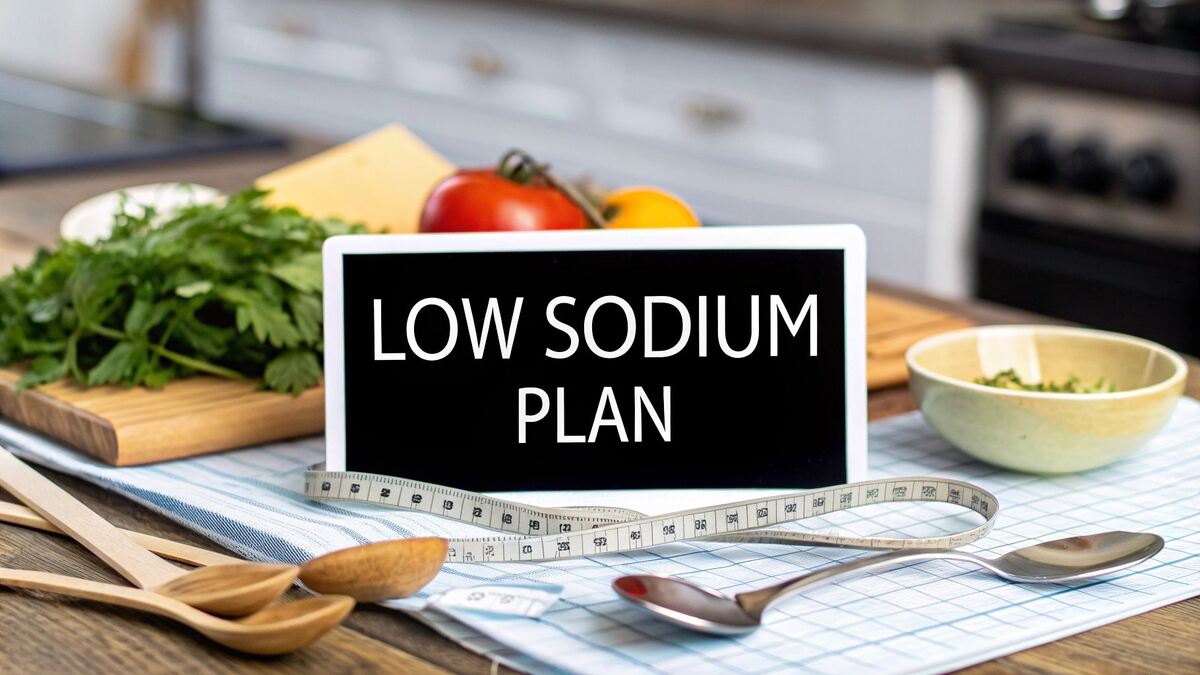Low Sodium Diet Plan: Easy Tips & Sample Meal Ideas
A low-sodium diet is simply an intentional way of eating that keeps your daily salt intake in check, usually somewhere below 2,300 milligrams. It’s less about restriction and more about making smarter choices—leaning into whole foods, getting savvy with nutrition labels, and steering clear of processed foods packed with hidden salt. Think of it as a practical tool for managing your blood pressure and protecting your heart.
Why Cutting Back on Salt Actually Matters
We’ve all heard the advice to "watch your salt," but it often feels like a vague suggestion. What does that really mean for your day-to-day life?
Think about that bloated feeling after a big meal out, or when your wedding ring suddenly feels tight. Those aren't random occurrences; they’re often your body's immediate reaction to too much sodium. This guide is here to connect those real-life moments to the bigger picture of your health.
Adopting a low-sodium plan isn't about deprivation. It's about taking back control over how you feel every day and making a proactive investment in your future health.
A Global Health Mission, Not Just a Personal Diet
This is bigger than just one person's health—it's a worldwide public health issue. Major health organizations are pushing for lower sodium consumption to combat chronic diseases on a global scale. It’s a powerful reminder that the small, conscious choices we make in our own kitchens ripple outward.
"Implementing sodium reduction policies is a 'best buy' for public health. It’s a cost-effective intervention that can prevent millions of premature deaths and save billions in healthcare costs."
Seeing it this way reframes the whole idea of a low-sodium diet. It’s not a chore; it’s an empowering step toward a healthier world. The World Health Organization (WHO) even set a goal to slash global sodium intake by 30% by 2025. We're not on track to meet it, but if we did, it could save an estimated 7 million lives by 2030. You can read more about the WHO's global sodium reduction efforts on their site.
For those looking into other wellness topics, you can find additional health and diet articles that offer a variety of perspectives. In the end, truly understanding why this matters is the best motivation for building a plan you can live with for the long haul.
Decoding Your Daily Sodium Needs
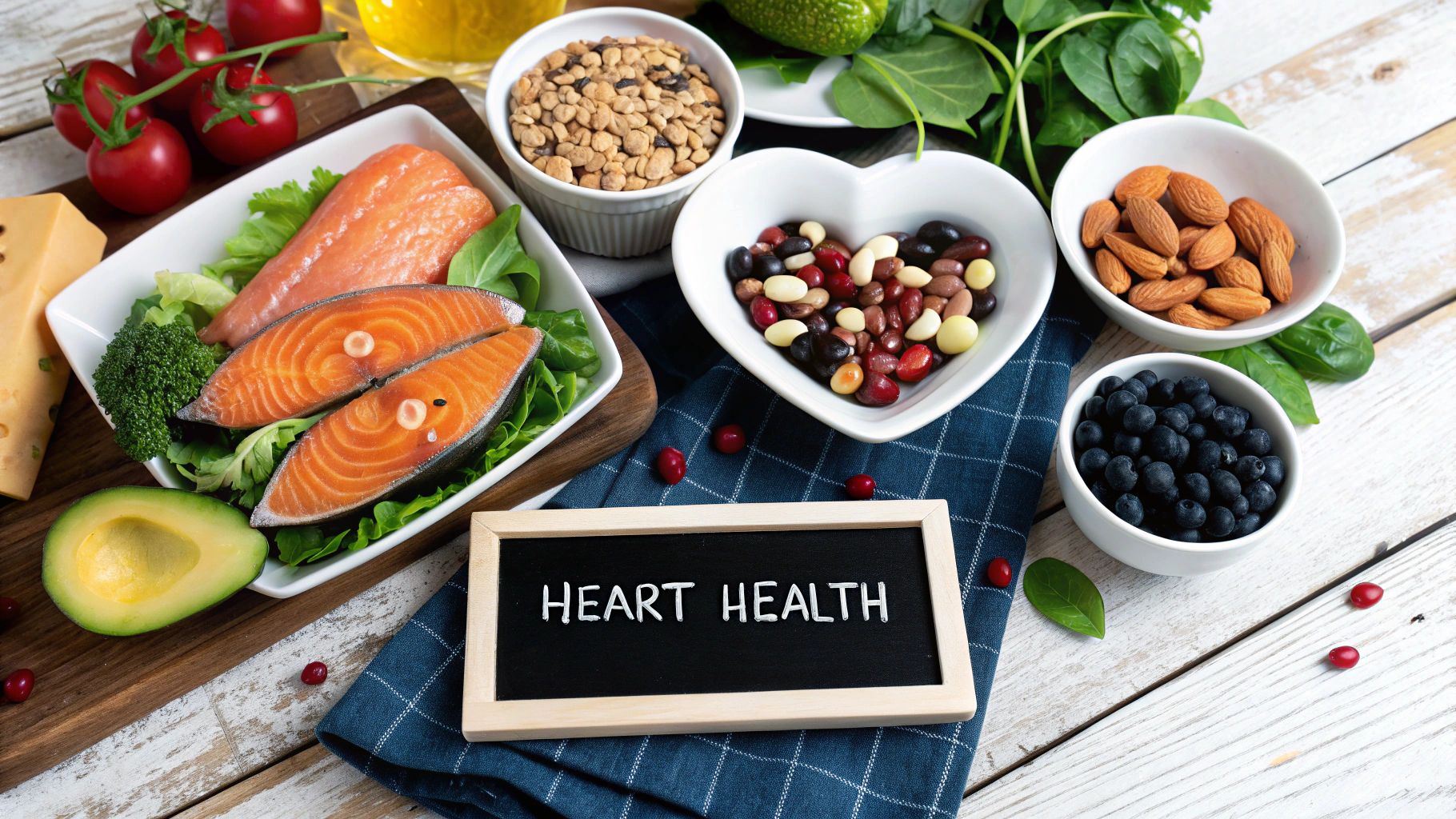
Before you can build a solid low-sodium meal plan, you need a target. Health organizations throw around numbers, but what do they actually mean for your day-to-day life? Let's get to the bottom of it.
The most common guideline, and the one you’ll see most often, is to keep your sodium under 2,300 milligrams (mg) per day. That’s about what you’d find in a single teaspoon of table salt. Sounds simple, right?
But for many people, especially if you're dealing with high blood pressure or have a family history of heart issues, doctors often suggest aiming even lower—closer to 1,500 mg per day. The health benefits can be significant.
Finding Your Personal Sodium Target
Here’s the thing: those numbers are just a starting point. Your ideal sodium intake isn't a one-size-fits-all prescription. Your body and your health history play a huge role.
A few key factors can shift your personal sodium goal:
- Health Conditions: If you're managing something like chronic kidney disease (CKD), heart failure, or hypertension, your doctor is going to put you on a much tighter sodium budget.
- Age: Our bodies often get more sensitive to sodium’s effect on blood pressure as we get older. It's a natural part of aging.
- Activity Level: A serious athlete sweating for hours might lose more sodium, but for most of us, a daily workout doesn't justify piling on the salt.
Your first move should always be a conversation with your doctor or a registered dietitian. They can look at the whole picture—your health, your lifestyle, your lab work—and give you a realistic sodium goal that’s right for you.
This personalized approach is what makes a plan stick. It's about meeting your body's specific needs, not just hitting an arbitrary number you read online.
The Stark Reality of Global Sodium Consumption
So, how are we actually doing with those recommendations? Not great. The gap between what we should eat and what we actually eat is massive, mostly thanks to the hidden sodium in processed foods and restaurant meals.
The global numbers are pretty eye-opening. A shocking 99.2% of the world's adult population eats more sodium than the World Health Organization recommends (less than 2,000 mg daily).
Here in the United States, the average person takes in about 3,600 mg of sodium per day. That's over 50% more than the upper recommended limit. If you want to dig deeper, you can explore more about these global salt consumption trends and see just how easy it is to blow past your daily limit without even realizing it.
Building Your Low Sodium Kitchen
Let’s be honest: a successful low-sodium plan isn't about sheer willpower. It's about setting up your kitchen for success. Lasting change happens when your pantry, fridge, and spice rack make the healthy choice the easy choice. This isn't about taking things away—it's about a strategic, flavorful upgrade.
We're going to get into the practical swaps that sidestep the high-sodium traps that can derail even the best intentions. By making a few smart adjustments, you create an environment that supports your health goals from the moment you open the cupboard.
Think about the gap between what's recommended and what most people actually eat.
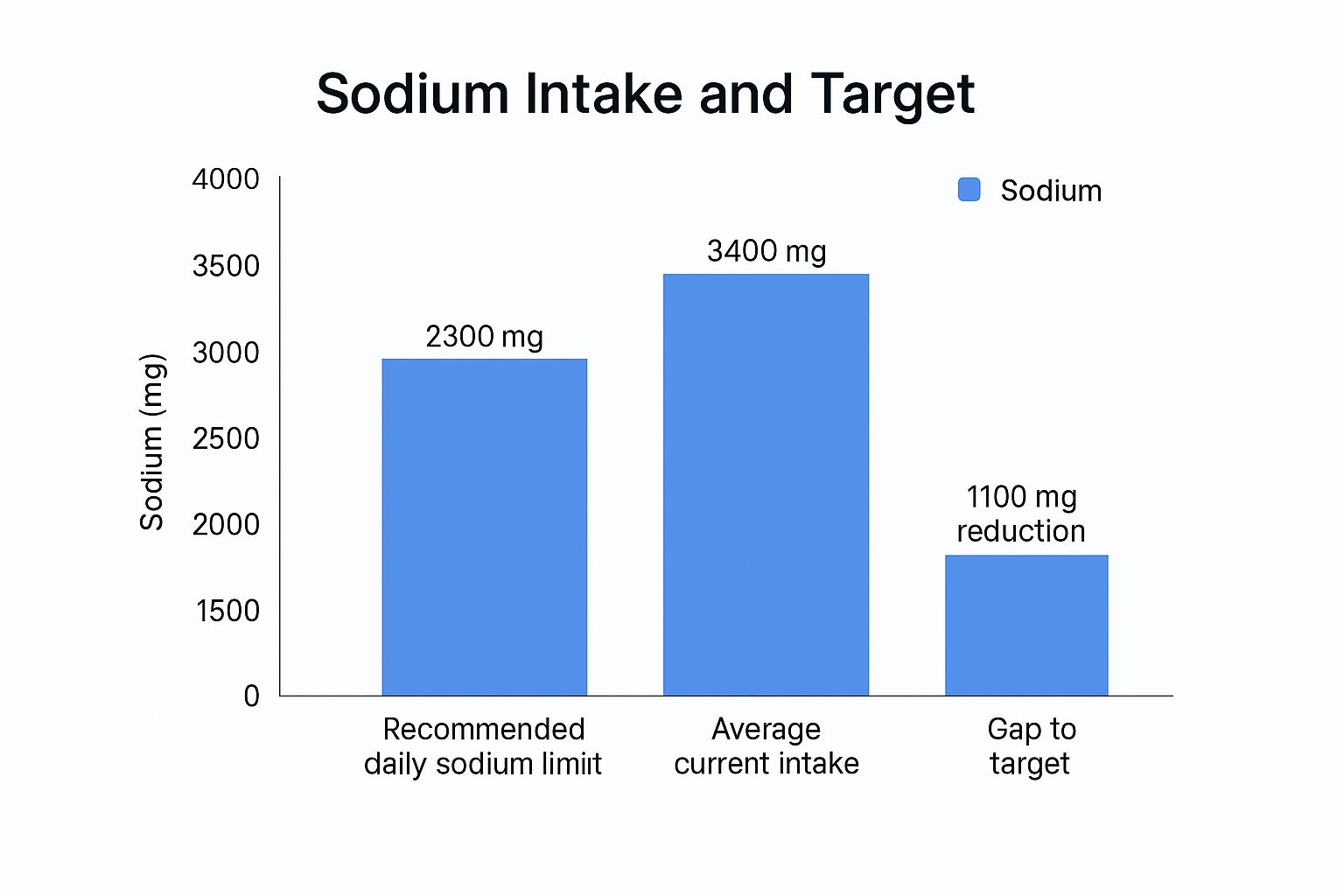
This visual shows that the average person consumes over 1,100 mg more sodium than the daily recommendation. That's a huge difference, and most of it sneaks in through common processed foods we all have in our kitchens.
Reinventing Your Pantry and Fridge
Time for a pantry audit. So many shelf-stable foods are packed with sodium for preservation—it's their dirty little secret. Think about canned soups, which can have over 800 mg of sodium in a single serving, or processed sauces and pre-packaged mixes. The goal is to spot these sodium bombs and find delicious, low-sodium alternatives.
A few powerful swaps can make all the difference:
- Rethink Canned Goods: Instead of regular canned veggies packed in salt, grab the ones labeled "No Salt Added." Here's a great tip: if you only have regular canned beans or vegetables, just rinse them thoroughly under running water. You can wash away up to 40% of the sodium this way.
- Swap Your Broth: A single cup of standard chicken broth can pack an astonishing 850 mg of sodium. Switching to low-sodium or unsalted versions is a game-changer, giving you total control over the salt in your soups, stews, and sauces.
- Conquer Condiments: Ketchup, soy sauce, and salad dressings are often loaded with hidden sodium. Look for low-sodium versions, or even better, start making your own. A simple homemade vinaigrette is not only healthier but tastes infinitely fresher.
And don't forget your drinks! Hydration is key, and choosing natural mineral water is an excellent way to stay refreshed. Options like Lurisia Water are a great fit for a clean, low-sodium lifestyle.
Key takeaway: Your environment shapes your habits. A kitchen stocked with low-sodium options removes decision fatigue and makes sticking to your plan feel almost automatic.
To make this even easier, here are some of the most common high-sodium culprits and what you can swap them with.
Smart Swaps For a Low Sodium Pantry
| High-Sodium Item | Low-Sodium Swap | Why It Matters |
|---|---|---|
| Regular Soy Sauce | Coconut Aminos or Low-Sodium Soy Sauce | A tablespoon of regular soy sauce can have 900+ mg of sodium. The swap gives you the same umami flavor for a fraction of the salt. |
| Canned Tuna in Brine | Canned Tuna in Water (No Salt Added) | The salt brine is a major source of hidden sodium. Tuna in water is just as versatile and puts you in control. |
| Pre-Made Seasoning Mixes | DIY Spice Blends | Those taco or chili packets are mostly salt. Mixing your own with cumin, chili powder, and paprika is cheaper and salt-free. |
| Jarred Pasta Sauce | "No Salt Added" Canned Crushed Tomatoes | Many jarred sauces have 500+ mg of sodium per serving. Starting with a plain tomato base lets you build flavor with herbs and garlic. |
| Salted Butter | Unsalted Butter | This simple swap can save you around 90 mg of sodium per tablespoon and gives you precise control over your cooking and baking. |
Making these changes during your next grocery run is one of the most effective steps you can take. It’s all about making the healthier choice the default.
Unleashing Flavor with Herbs and Spices
One of the biggest fears people have when cutting back on sodium is that their food will be bland and boring. Nothing could be further from the truth. Your spice rack is about to become your new best friend. Herbs and spices are the secret to creating deep, complex flavors without a single grain of added salt.
Instead of reaching for the salt shaker, start experimenting with these flavor powerhouses:
- Smoked Paprika: This adds an incredible smoky, savory depth to everything from roasted chicken to potatoes.
- Garlic & Onion Powder: These are the foundational flavors for almost any savory dish. Just make sure you grab the pure powders, not garlic salt or onion salt.
- Dried Herbs: Basil, oregano, thyme, and rosemary bring that classic aromatic flavor perfect for Mediterranean-inspired meals.
- Cumin & Coriander: These bring warm, earthy notes that are essential for Mexican, Indian, and Middle Eastern cuisines.
By building a solid collection of spices, you empower yourself to create genuinely exciting and satisfying meals. This shift in mindset—from salting to seasoning—is the real key to enjoying food while protecting your health.
Mastering Flavor Without the Salt
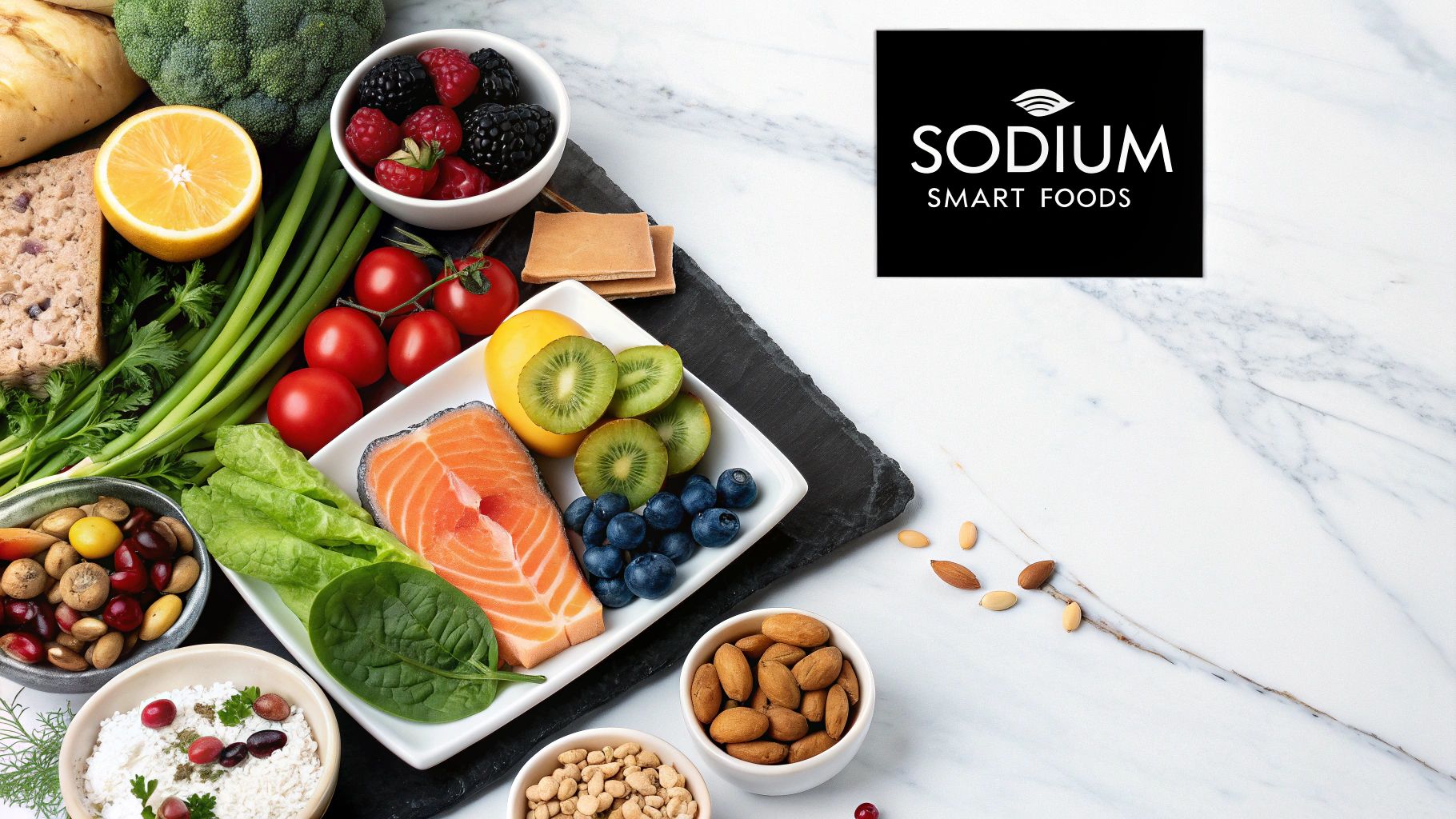
Let's be honest: the biggest hurdle for anyone starting a low-sodium plan is the fear of bland, tasteless food. It’s a completely valid concern, but one we can put to rest right now. This isn't about stripping away flavor; it's about becoming a more creative and intuitive cook. You're about to learn how to build incredible taste from the ground up, without ever reaching for the salt shaker.
I like to think of salt as a single, loud instrument in an orchestra. When you take it away, you suddenly start to hear all the other instruments more clearly. Your goal is to conduct this new orchestra of flavors, creating dishes that are more complex and satisfying than you thought possible. This is your chance to move from just salting your food to truly seasoning it.
The Foundation of Flavor: Aromatics
Every great, savory dish begins with aromatics. These are the fragrant vegetables and herbs that release deep, foundational flavors when heated. Sautéing finely chopped onions, garlic, and celery in a touch of olive oil creates a classic base known as a mirepoix, which enriches everything from soups to sauces.
But don't stop there. Experiment with leeks for a milder oniony taste, shallots for a hint of sweetness, or colorful bell peppers to change the flavor profile entirely. Gently cooking them coaxes out their natural sugars and savory notes, providing a depth that salt alone could never replicate. This simple technique is an absolute game-changer for flavor-packed, low-sodium cooking.
The Power of Brightness and Umami
Once you've built that savory base, it's time to layer in complexity. This is where you introduce brightness and that rich, satisfying taste we call umami.
- Citrus is Your Secret Weapon: A squeeze of fresh lemon or lime juice at the very end of cooking can instantly wake up a dish, making all the other flavors pop. It adds a "zing" that our taste buds often associate with salt.
- Harness Umami: Umami is the fifth taste, often described as savory or meaty. You can find it in abundance in low-sodium ingredients like mushrooms, ripe tomatoes (especially when roasted!), and nutritional yeast. Adding these to your cooking creates a deep, satisfying richness that makes food feel complete.
A fantastic trick I've learned is to make a paste of sautéed mushrooms and garlic. Stir it into stews or spread it on chicken before baking. It delivers an incredible savory punch that will make you completely forget about salt.
Your New Best Friends: Herbs and Spices
Finally, your spice rack is where you unlock endless flavor combinations. My best advice is to ditch the pre-made seasoning packets, which are almost always loaded with sodium, and start blending your own.
Here are a few of my essential salt-free powerhouses to get you started:
- Smoked Paprika: This adds a smoky, almost bacon-like flavor to roasted vegetables and meats. It's a must-have.
- Cumin and Coriander: These provide warm, earthy notes that are perfect for everything from taco fillings to chili.
- Garlic and Onion Powder: Just be sure you buy the pure powders, not garlic salt or onion salt. They provide a concentrated savory kick without any sodium.
By embracing these techniques, you're not just cutting out salt—you're adding a whole new world of flavor to your low-sodium diet plan.
A Taste of What Your Week Could Look Like: A 7-Day Low-Sodium Plan
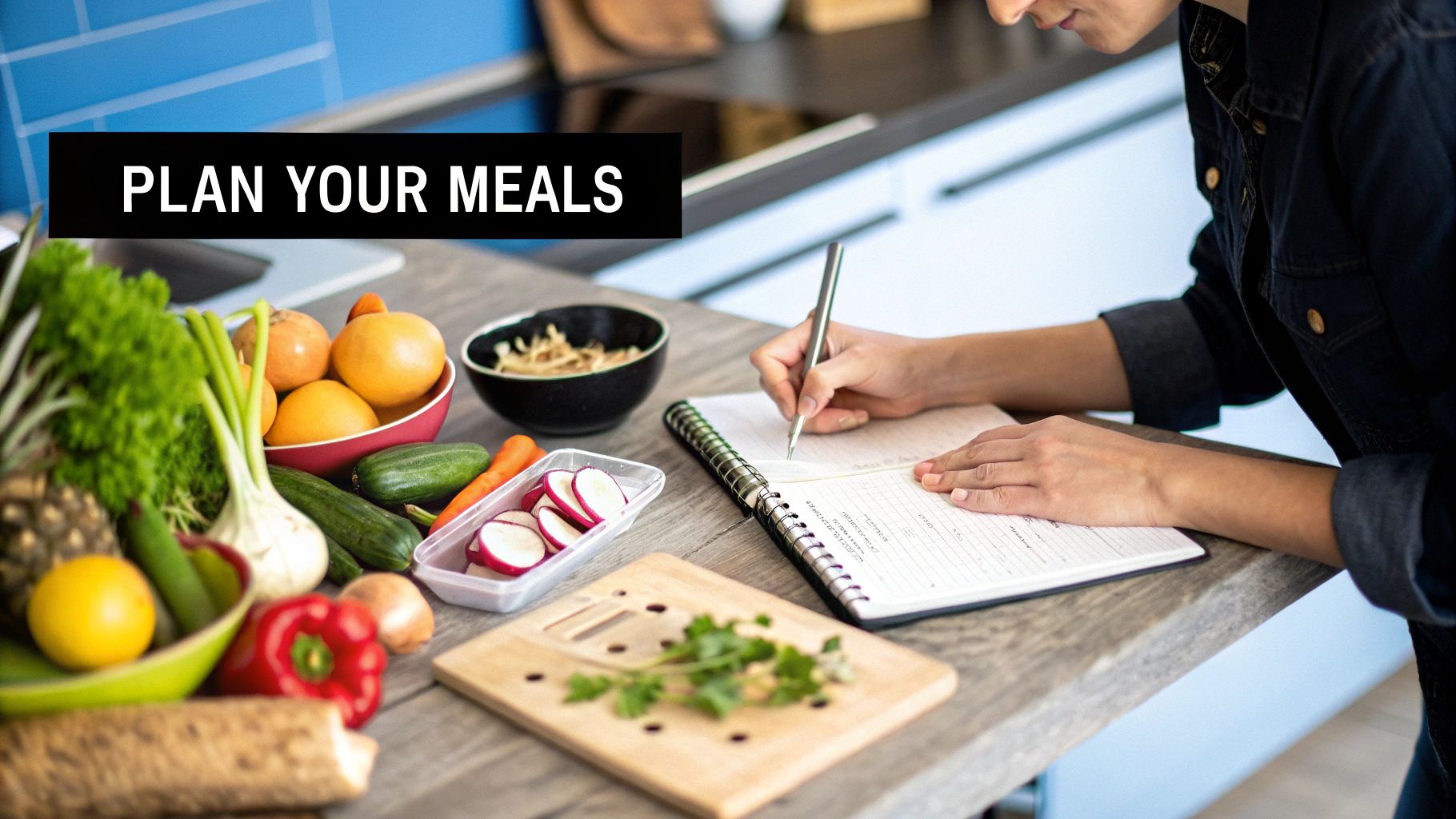
Alright, theory is one thing, but what does this actually look like on a plate? Let's walk through a sample week of low-sodium eating.
This isn't a rigid, must-follow-to-the-letter diet. Think of it as a launchpad—a real-world example to show you just how flavorful and satisfying cutting back on sodium can be. It’s built around whole foods and simple cooking, proving you don't need a salt shaker to make a great meal.
Feel free to mix it up! Swap the chicken for fish, use your favorite veggies, or adjust portions based on your own hunger and health needs. The real takeaway here is the pattern: fresh ingredients, smart seasoning, and delicious results.
Your Weekly Game Plan
You’ll notice some meals repeat, and that’s by design. It’s one of my favorite strategies for saving time and money. Cook a bigger batch of quinoa or grill a few extra chicken breasts at the start of the week, and you’ve got the foundation for several quick and easy meals later on.
Monday: Let's kick things off with some simple, clean flavors.
- Breakfast: A warm bowl of oatmeal, made with milk or water. Top it with a handful of fresh berries and a good sprinkle of cinnamon.
- Lunch: A big spinach salad topped with grilled chicken breast, fresh cucumber, bell peppers, and a drizzle of homemade lemon-herb vinaigrette.
- Dinner: Baked salmon seasoned with fresh dill and a squeeze of lemon. Serve it alongside some roasted asparagus and a scoop of quinoa.
Tuesday: We'll build on yesterday's success, using leftovers to make life easier.
- Breakfast: Plain Greek yogurt with some juicy sliced peaches and a handful of unsalted almonds for a nice crunch.
- Lunch: That delicious leftover salmon and quinoa from last night’s dinner. Easy.
- Dinner: Homemade turkey meatballs—skip the salt and go heavy on herbs like oregano and basil. Serve them over zucchini noodles with a no-salt-added tomato sauce.
Globally, the push for lower sodium is gaining serious momentum. Experts have even proposed a 10-year plan to help bring the average daily sodium intake down from around 4,300 mg to the recommended 2,000 mg. The health and economic upsides are massive, especially for improving blood pressure and cardiovascular health across our aging population.
Mid-Week Meals and Weekend Wins
As you get into the rhythm of the week, keep your focus on fresh ingredients and flavor-packed herbs and spices.
Wednesday: Simple, satisfying, and full of flavor.
- Breakfast: Two scrambled eggs with sautéed spinach and mushrooms. A little black pepper and garlic powder is all you need.
- Lunch: Leftover turkey meatballs and zoodles. Done.
- Dinner: A quick chicken and veggie stir-fry. Use low-sodium soy sauce and load it up with broccoli, carrots, and snap peas, served over brown rice.
Thursday: Let's bring back a couple of favorites to keep things simple.
- Breakfast: Oatmeal with fresh berries and cinnamon again.
- Lunch: That same great spinach and grilled chicken salad from Monday.
- Dinner: Enjoy the leftover chicken stir-fry from Wednesday. No cooking required!
My Weekend Pro-Tip: Use the weekend to get a little creative and prep for the week ahead. Make a big pot of unsalted lentil soup for easy lunches, or grill up some extra chicken for salads. A little work now saves a lot of time later.
Here's how you can round out the week:
Friday:
- Breakfast: Greek yogurt with peaches and almonds.
- Lunch: Make a quick wrap with a low-sodium tortilla. Fill it with chickpeas, shredded carrots, cucumber, and a simple yogurt-dill sauce.
- Dinner: Homemade pizza night! Use a whole-wheat crust, no-salt-added tomato sauce, fresh mozzarella, and pile on the veggies.
Saturday:
- Breakfast: Scrambled eggs with sautéed veggies.
- Lunch: A slice (or two) of that leftover pizza.
- Dinner: Make lean ground beef burgers on whole-wheat buns. Load them up with lettuce, tomato, and onion. On the side, bake some sweet potato wedges seasoned with paprika instead of salt.
Sunday:
- Breakfast: Treat yourself to some whole-wheat pancakes topped with fresh fruit and a little maple syrup.
- Lunch: Finish up those leftover burgers.
- Dinner: A classic Sunday dinner: roasted chicken with a medley of root vegetables like carrots and potatoes, all seasoned beautifully with rosemary and thyme.
If you love this structure but want it personalized, technology can be a huge help. You can explore how an AI Meal Planner can generate custom low-sodium menus that are built around your specific tastes and goals. Consider this sample plan your first step on a very delicious journey.
Navigating Real-Life Low Sodium Challenges
https://www.youtube.com/embed/NO-EbXMB4gc
It’s one thing to get your low-sodium plan down pat in your own kitchen, where you have total control. But what happens when you step out into the real world? Between restaurant meals, holiday parties, and family dinners, sticking to your goals can feel like an uphill battle. This is where the real test begins, and having a good strategy makes all the difference.
Let's be honest—you can't just avoid social situations forever. The secret isn't hiding from them; it's learning how to navigate them with confidence. A little bit of prep work before you even leave the house is your best defense.
Dining Out Without the Guilt
Restaurants can be a minefield of hidden sodium. Chefs rely on salt to make flavors pop, and countless sauces, dressings, and marinades come pre-packaged and loaded with the stuff. Even so, you're not powerless.
Your first move should be a little online detective work. Most places have their menus online, giving you a chance to spot potentially safe options ahead of time. I always look for simple dishes centered on whole foods—think grilled fish, roasted chicken, or a hearty salad.
When you’re ready to order, a few simple requests can slash your sodium intake:
- Ask for simple preparations. A piece of fish or chicken that's been grilled, baked, or broiled without salt is a great starting point.
- Get sauces on the side. This is a game-changer. Instead of a salad drowning in dressing, you can add just a small amount for flavor.
- Don't be afraid to be direct. A polite, "I'm on a low-sodium diet for health reasons. Could the chef prepare my dish without any added salt or salty seasonings?" goes a long way. Most kitchens are more than willing to accommodate.
My personal go-to is ordering a steak or a piece of salmon with a side of steamed vegetables and a plain baked potato. It’s a clean, simple meal that’s nearly impossible to mess up, and I can add flavor myself with fresh pepper or a squeeze of lemon.
Handling Social Gatherings and Family Meals
Potlucks, holiday feasts, and summer barbecues can feel like navigating a minefield when you're watching your sodium. The social pressure to dig in is real, but your health has to come first.
One of the best strategies I've found is to bring a dish you know is safe for you to eat. That way, you’re guaranteed to have at least one delicious, low-sodium option. Plus, it's a great way to show friends and family how amazing low-salt cooking can be. A vibrant quinoa salad, a tray of herb-roasted veggies, or a flavorful black bean dip with fresh-cut vegetables are always a hit.
If you’re heading to someone's home for dinner, a quiet word with the host beforehand can work wonders. Just a simple, "I am so looking forward to dinner tonight! Just wanted to give you a heads-up that I have to watch my salt intake, so I might have to pass on a few things. Can't wait to see you!" It sets expectations gracefully without making a big scene.
When Your Taste Buds Rebel
Let’s talk about one of the biggest hurdles: the taste adjustment. If you’ve spent years eating a typical high-sodium diet, your taste buds have become desensitized. Food is probably going to taste bland at first. That's totally normal, and more importantly, it’s temporary.
It usually takes a few weeks for your palate to recalibrate and become more sensitive to subtle flavors. In the meantime, really lean into those other flavor-building tools we've talked about—fresh herbs, bold spices, garlic, onion, citrus juice, and different kinds of vinegar.
Be patient with yourself. Every meal is another step toward retraining your taste buds. Before you know it, you’ll take a bite of something you used to love and find it overwhelmingly salty. That's a huge milestone, and it’s the moment you know all your effort has truly paid off.
Ready to take the guesswork out of your low sodium diet plan? The AI Meal Planner creates personalized weekly menus based on your specific health goals and taste preferences. Stop struggling with what to eat and let us build a delicious, satisfying plan just for you. Get your custom low-sodium meal plan today!
AI-powered nutrition
Get Your Personalized Meal Plan
AI creates the perfect meals for your goals, lifestyle, and taste.
Start Your Journej
